Analysis of Fructosamine and Glycated Albumin in Diabetes Management
VerifiedAdded on 2022/12/26
|6
|1146
|68
Report
AI Summary
This report provides a detailed analysis of fructosamine and glycated albumin as diagnostic tools for diabetes. The study examines the advantages and disadvantages of these biomarkers in the diagnosis and management of the disease, referencing the latest standards of medical care from the American Diabetes Association. The report delves into the efficacy of these tools in various clinical settings, including gestational diabetes, and compares their performance with traditional methods like HbA1c. It discusses the limitations and benefits of fructosamine and glycated albumin in specific patient populations, such as those with conditions affecting HbA1c testing. The conclusion emphasizes the importance of early diagnosis and effective glucose regulation in preventing diabetes complications, while acknowledging the role of fructosamine and GA as potential alternatives to HbA1c in specific cases. The report includes references to key research and clinical trials, providing a comprehensive overview of the current landscape of diabetes diagnosis and treatment, and the role of these diagnostic tools.
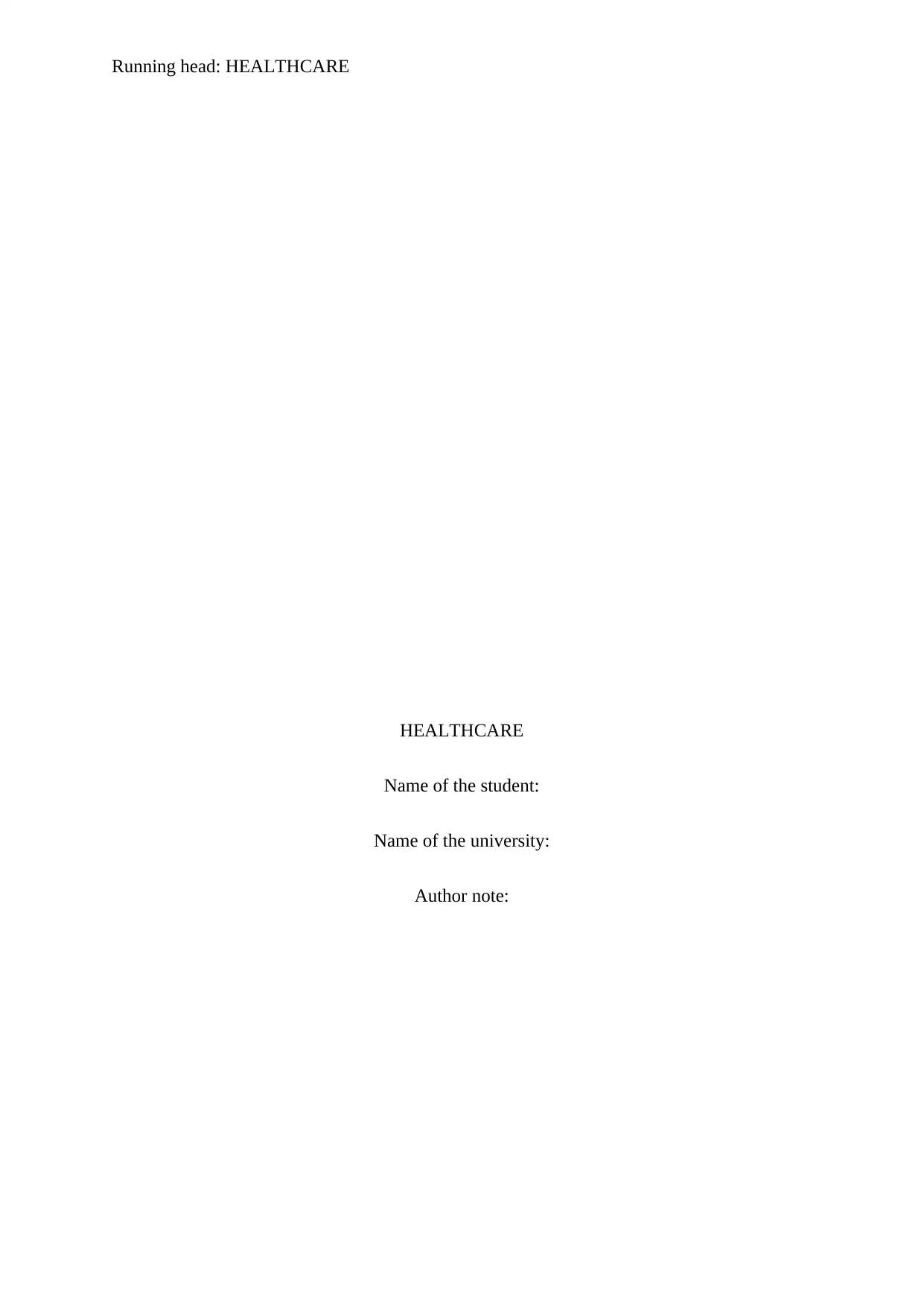
Running head: HEALTHCARE
HEALTHCARE
Name of the student:
Name of the university:
Author note:
HEALTHCARE
Name of the student:
Name of the university:
Author note:
Paraphrase This Document
Need a fresh take? Get an instant paraphrase of this document with our AI Paraphraser
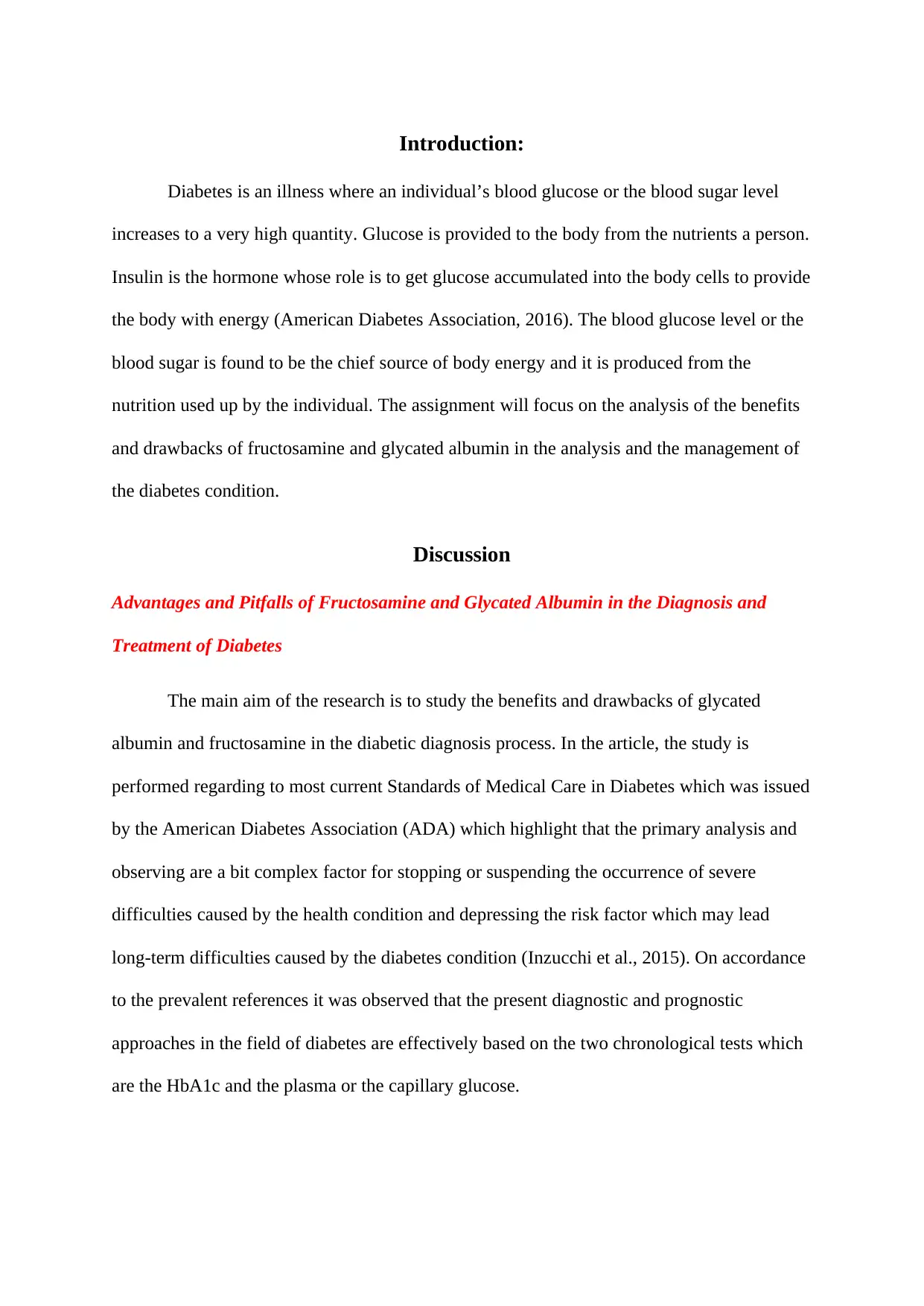
Introduction:
Diabetes is an illness where an individual’s blood glucose or the blood sugar level
increases to a very high quantity. Glucose is provided to the body from the nutrients a person.
Insulin is the hormone whose role is to get glucose accumulated into the body cells to provide
the body with energy (American Diabetes Association, 2016). The blood glucose level or the
blood sugar is found to be the chief source of body energy and it is produced from the
nutrition used up by the individual. The assignment will focus on the analysis of the benefits
and drawbacks of fructosamine and glycated albumin in the analysis and the management of
the diabetes condition.
Discussion
Advantages and Pitfalls of Fructosamine and Glycated Albumin in the Diagnosis and
Treatment of Diabetes
The main aim of the research is to study the benefits and drawbacks of glycated
albumin and fructosamine in the diabetic diagnosis process. In the article, the study is
performed regarding to most current Standards of Medical Care in Diabetes which was issued
by the American Diabetes Association (ADA) which highlight that the primary analysis and
observing are a bit complex factor for stopping or suspending the occurrence of severe
difficulties caused by the health condition and depressing the risk factor which may lead
long-term difficulties caused by the diabetes condition (Inzucchi et al., 2015). On accordance
to the prevalent references it was observed that the present diagnostic and prognostic
approaches in the field of diabetes are effectively based on the two chronological tests which
are the HbA1c and the plasma or the capillary glucose.
Diabetes is an illness where an individual’s blood glucose or the blood sugar level
increases to a very high quantity. Glucose is provided to the body from the nutrients a person.
Insulin is the hormone whose role is to get glucose accumulated into the body cells to provide
the body with energy (American Diabetes Association, 2016). The blood glucose level or the
blood sugar is found to be the chief source of body energy and it is produced from the
nutrition used up by the individual. The assignment will focus on the analysis of the benefits
and drawbacks of fructosamine and glycated albumin in the analysis and the management of
the diabetes condition.
Discussion
Advantages and Pitfalls of Fructosamine and Glycated Albumin in the Diagnosis and
Treatment of Diabetes
The main aim of the research is to study the benefits and drawbacks of glycated
albumin and fructosamine in the diabetic diagnosis process. In the article, the study is
performed regarding to most current Standards of Medical Care in Diabetes which was issued
by the American Diabetes Association (ADA) which highlight that the primary analysis and
observing are a bit complex factor for stopping or suspending the occurrence of severe
difficulties caused by the health condition and depressing the risk factor which may lead
long-term difficulties caused by the diabetes condition (Inzucchi et al., 2015). On accordance
to the prevalent references it was observed that the present diagnostic and prognostic
approaches in the field of diabetes are effectively based on the two chronological tests which
are the HbA1c and the plasma or the capillary glucose.
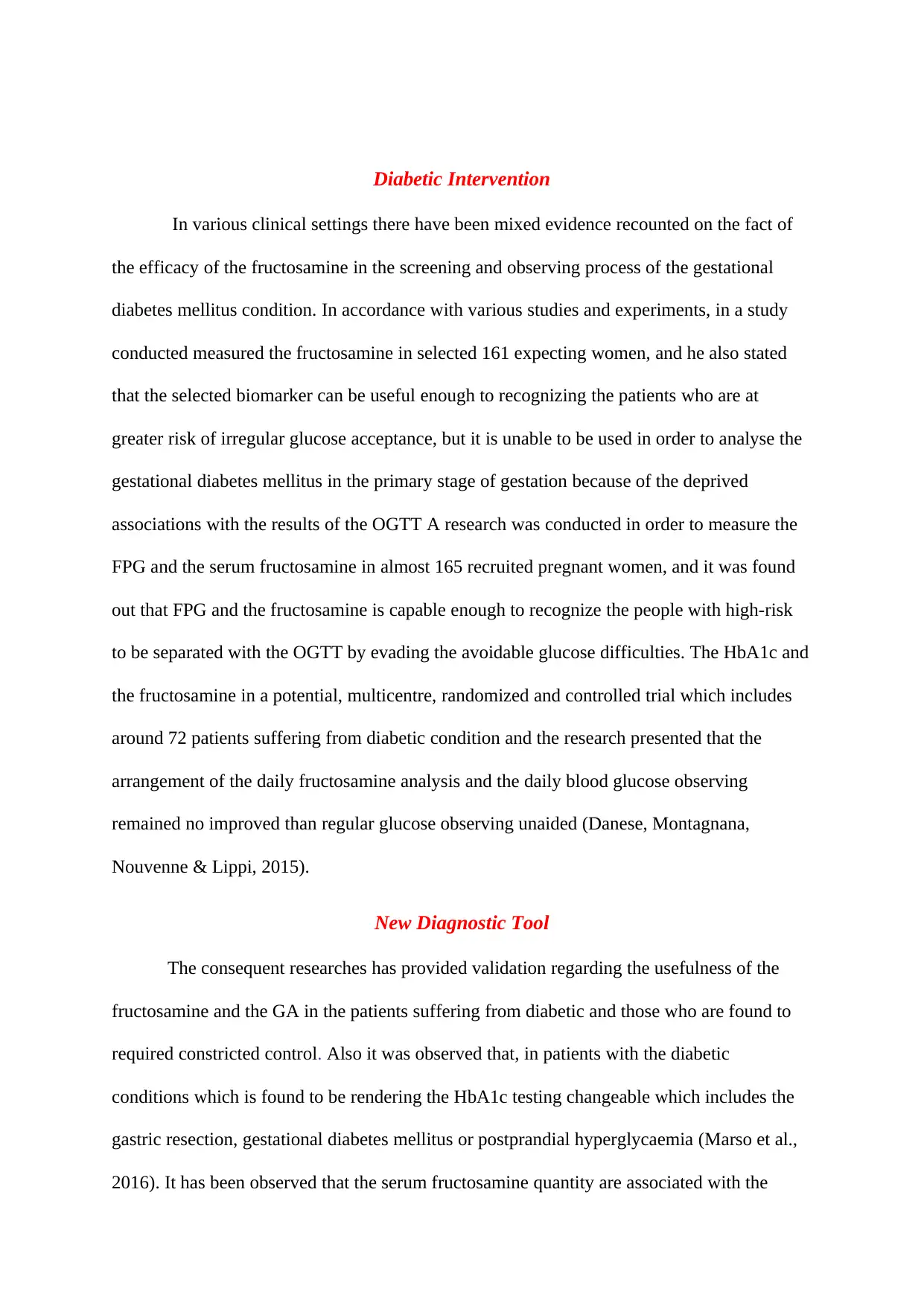
Diabetic Intervention
In various clinical settings there have been mixed evidence recounted on the fact of
the efficacy of the fructosamine in the screening and observing process of the gestational
diabetes mellitus condition. In accordance with various studies and experiments, in a study
conducted measured the fructosamine in selected 161 expecting women, and he also stated
that the selected biomarker can be useful enough to recognizing the patients who are at
greater risk of irregular glucose acceptance, but it is unable to be used in order to analyse the
gestational diabetes mellitus in the primary stage of gestation because of the deprived
associations with the results of the OGTT A research was conducted in order to measure the
FPG and the serum fructosamine in almost 165 recruited pregnant women, and it was found
out that FPG and the fructosamine is capable enough to recognize the people with high-risk
to be separated with the OGTT by evading the avoidable glucose difficulties. The HbA1c and
the fructosamine in a potential, multicentre, randomized and controlled trial which includes
around 72 patients suffering from diabetic condition and the research presented that the
arrangement of the daily fructosamine analysis and the daily blood glucose observing
remained no improved than regular glucose observing unaided (Danese, Montagnana,
Nouvenne & Lippi, 2015).
New Diagnostic Tool
The consequent researches has provided validation regarding the usefulness of the
fructosamine and the GA in the patients suffering from diabetic and those who are found to
required constricted control. Also it was observed that, in patients with the diabetic
conditions which is found to be rendering the HbA1c testing changeable which includes the
gastric resection, gestational diabetes mellitus or postprandial hyperglycaemia (Marso et al.,
2016). It has been observed that the serum fructosamine quantity are associated with the
In various clinical settings there have been mixed evidence recounted on the fact of
the efficacy of the fructosamine in the screening and observing process of the gestational
diabetes mellitus condition. In accordance with various studies and experiments, in a study
conducted measured the fructosamine in selected 161 expecting women, and he also stated
that the selected biomarker can be useful enough to recognizing the patients who are at
greater risk of irregular glucose acceptance, but it is unable to be used in order to analyse the
gestational diabetes mellitus in the primary stage of gestation because of the deprived
associations with the results of the OGTT A research was conducted in order to measure the
FPG and the serum fructosamine in almost 165 recruited pregnant women, and it was found
out that FPG and the fructosamine is capable enough to recognize the people with high-risk
to be separated with the OGTT by evading the avoidable glucose difficulties. The HbA1c and
the fructosamine in a potential, multicentre, randomized and controlled trial which includes
around 72 patients suffering from diabetic condition and the research presented that the
arrangement of the daily fructosamine analysis and the daily blood glucose observing
remained no improved than regular glucose observing unaided (Danese, Montagnana,
Nouvenne & Lippi, 2015).
New Diagnostic Tool
The consequent researches has provided validation regarding the usefulness of the
fructosamine and the GA in the patients suffering from diabetic and those who are found to
required constricted control. Also it was observed that, in patients with the diabetic
conditions which is found to be rendering the HbA1c testing changeable which includes the
gastric resection, gestational diabetes mellitus or postprandial hyperglycaemia (Marso et al.,
2016). It has been observed that the serum fructosamine quantity are associated with the
⊘ This is a preview!⊘
Do you want full access?
Subscribe today to unlock all pages.

Trusted by 1+ million students worldwide
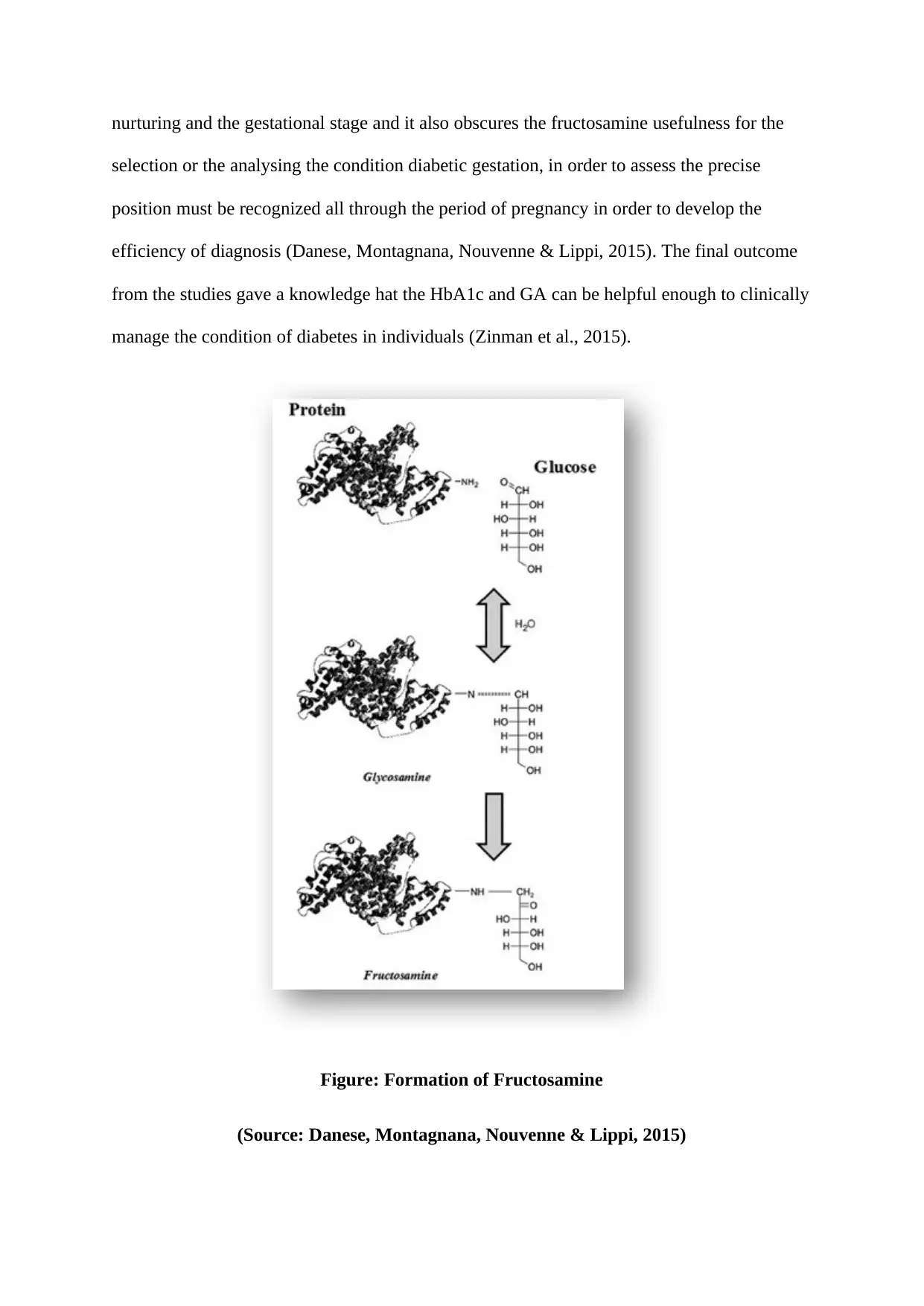
nurturing and the gestational stage and it also obscures the fructosamine usefulness for the
selection or the analysing the condition diabetic gestation, in order to assess the precise
position must be recognized all through the period of pregnancy in order to develop the
efficiency of diagnosis (Danese, Montagnana, Nouvenne & Lippi, 2015). The final outcome
from the studies gave a knowledge hat the HbA1c and GA can be helpful enough to clinically
manage the condition of diabetes in individuals (Zinman et al., 2015).
Figure: Formation of Fructosamine
(Source: Danese, Montagnana, Nouvenne & Lippi, 2015)
selection or the analysing the condition diabetic gestation, in order to assess the precise
position must be recognized all through the period of pregnancy in order to develop the
efficiency of diagnosis (Danese, Montagnana, Nouvenne & Lippi, 2015). The final outcome
from the studies gave a knowledge hat the HbA1c and GA can be helpful enough to clinically
manage the condition of diabetes in individuals (Zinman et al., 2015).
Figure: Formation of Fructosamine
(Source: Danese, Montagnana, Nouvenne & Lippi, 2015)
Paraphrase This Document
Need a fresh take? Get an instant paraphrase of this document with our AI Paraphraser
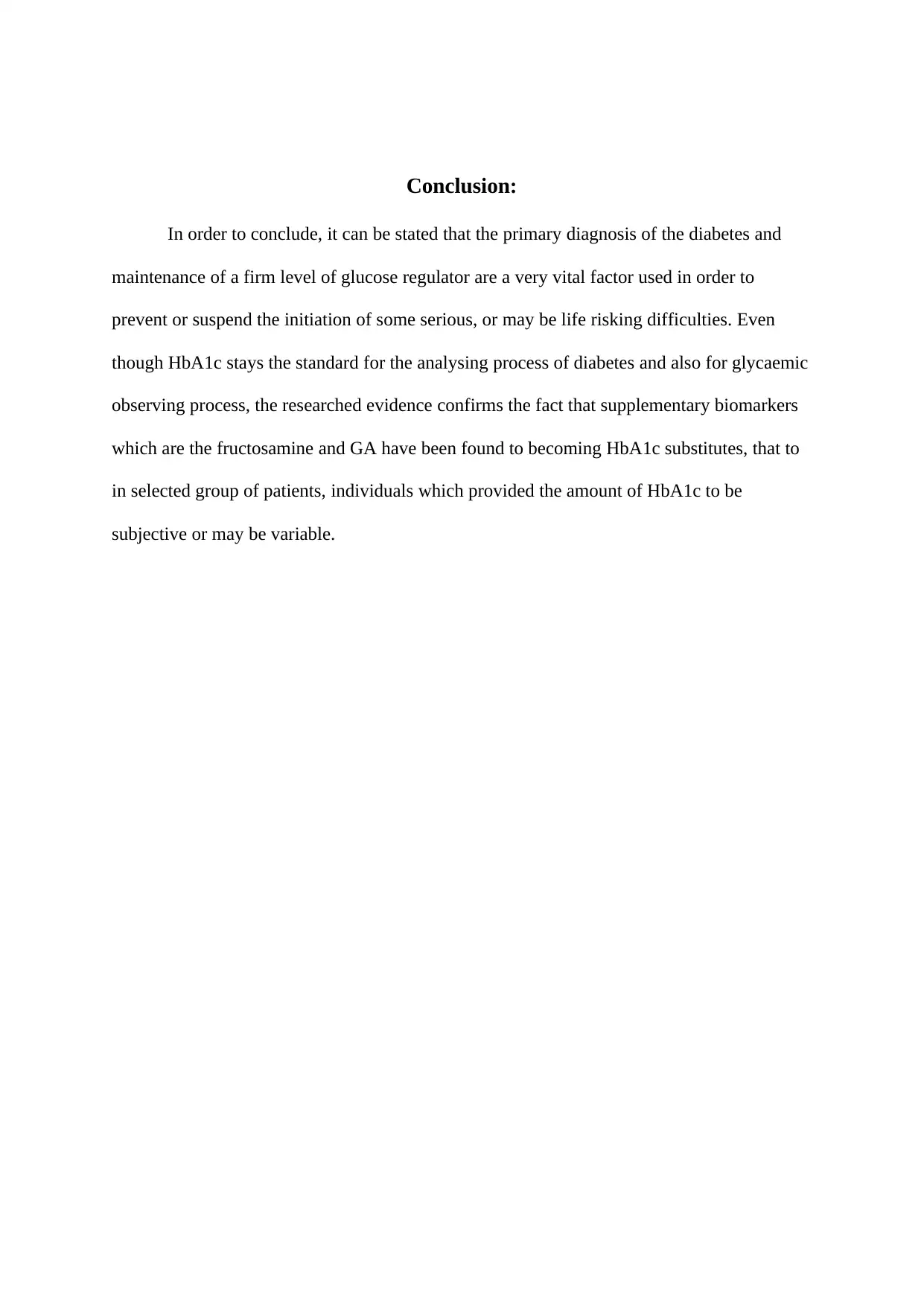
Conclusion:
In order to conclude, it can be stated that the primary diagnosis of the diabetes and
maintenance of a firm level of glucose regulator are a very vital factor used in order to
prevent or suspend the initiation of some serious, or may be life risking difficulties. Even
though HbA1c stays the standard for the analysing process of diabetes and also for glycaemic
observing process, the researched evidence confirms the fact that supplementary biomarkers
which are the fructosamine and GA have been found to becoming HbA1c substitutes, that to
in selected group of patients, individuals which provided the amount of HbA1c to be
subjective or may be variable.
In order to conclude, it can be stated that the primary diagnosis of the diabetes and
maintenance of a firm level of glucose regulator are a very vital factor used in order to
prevent or suspend the initiation of some serious, or may be life risking difficulties. Even
though HbA1c stays the standard for the analysing process of diabetes and also for glycaemic
observing process, the researched evidence confirms the fact that supplementary biomarkers
which are the fructosamine and GA have been found to becoming HbA1c substitutes, that to
in selected group of patients, individuals which provided the amount of HbA1c to be
subjective or may be variable.
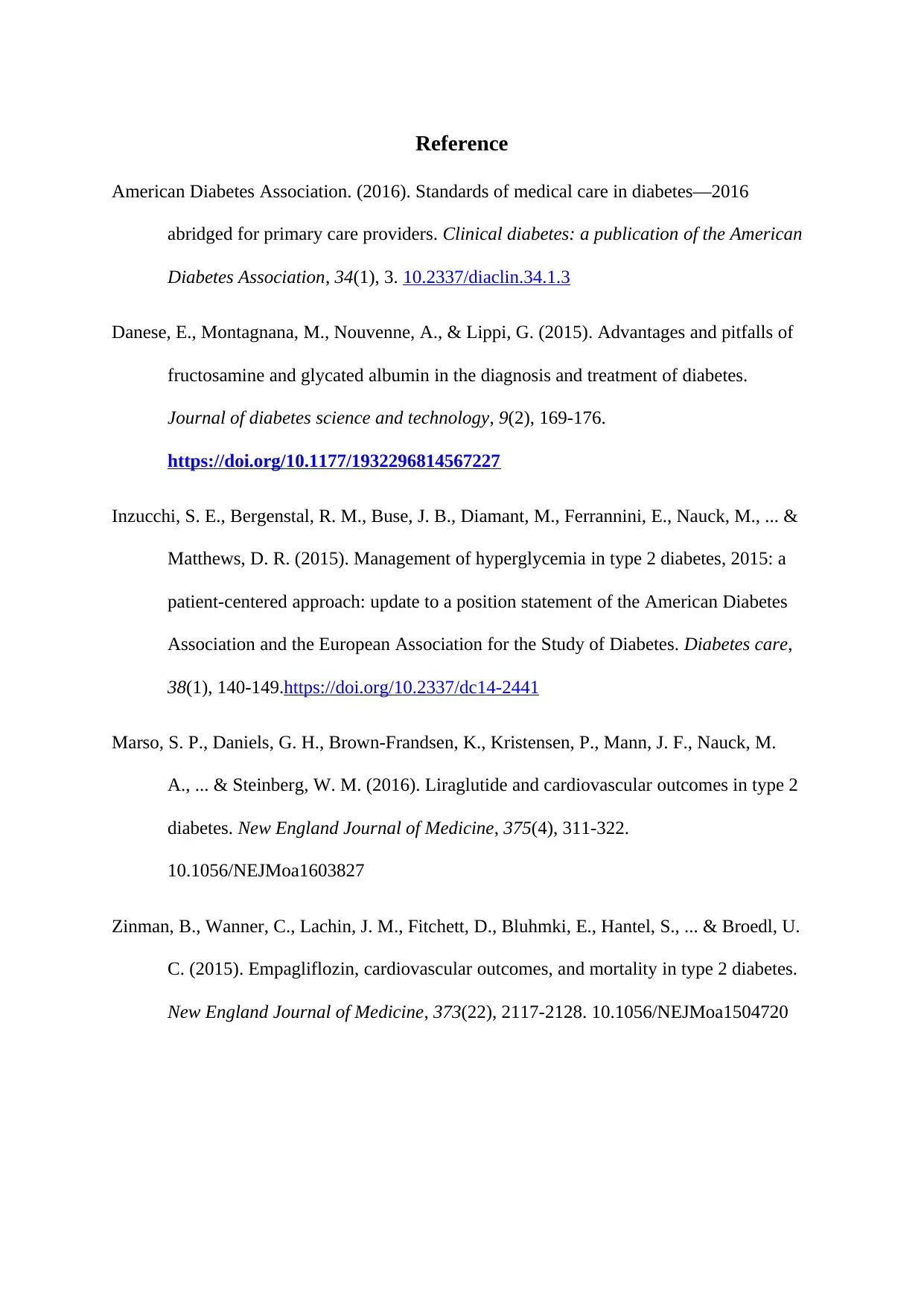
Reference
American Diabetes Association. (2016). Standards of medical care in diabetes—2016
abridged for primary care providers. Clinical diabetes: a publication of the American
Diabetes Association, 34(1), 3. 10.2337/diaclin.34.1.3
Danese, E., Montagnana, M., Nouvenne, A., & Lippi, G. (2015). Advantages and pitfalls of
fructosamine and glycated albumin in the diagnosis and treatment of diabetes.
Journal of diabetes science and technology, 9(2), 169-176.
https://doi.org/10.1177/1932296814567227
Inzucchi, S. E., Bergenstal, R. M., Buse, J. B., Diamant, M., Ferrannini, E., Nauck, M., ... &
Matthews, D. R. (2015). Management of hyperglycemia in type 2 diabetes, 2015: a
patient-centered approach: update to a position statement of the American Diabetes
Association and the European Association for the Study of Diabetes. Diabetes care,
38(1), 140-149.https://doi.org/10.2337/dc14-2441
Marso, S. P., Daniels, G. H., Brown-Frandsen, K., Kristensen, P., Mann, J. F., Nauck, M.
A., ... & Steinberg, W. M. (2016). Liraglutide and cardiovascular outcomes in type 2
diabetes. New England Journal of Medicine, 375(4), 311-322.
10.1056/NEJMoa1603827
Zinman, B., Wanner, C., Lachin, J. M., Fitchett, D., Bluhmki, E., Hantel, S., ... & Broedl, U.
C. (2015). Empagliflozin, cardiovascular outcomes, and mortality in type 2 diabetes.
New England Journal of Medicine, 373(22), 2117-2128. 10.1056/NEJMoa1504720
American Diabetes Association. (2016). Standards of medical care in diabetes—2016
abridged for primary care providers. Clinical diabetes: a publication of the American
Diabetes Association, 34(1), 3. 10.2337/diaclin.34.1.3
Danese, E., Montagnana, M., Nouvenne, A., & Lippi, G. (2015). Advantages and pitfalls of
fructosamine and glycated albumin in the diagnosis and treatment of diabetes.
Journal of diabetes science and technology, 9(2), 169-176.
https://doi.org/10.1177/1932296814567227
Inzucchi, S. E., Bergenstal, R. M., Buse, J. B., Diamant, M., Ferrannini, E., Nauck, M., ... &
Matthews, D. R. (2015). Management of hyperglycemia in type 2 diabetes, 2015: a
patient-centered approach: update to a position statement of the American Diabetes
Association and the European Association for the Study of Diabetes. Diabetes care,
38(1), 140-149.https://doi.org/10.2337/dc14-2441
Marso, S. P., Daniels, G. H., Brown-Frandsen, K., Kristensen, P., Mann, J. F., Nauck, M.
A., ... & Steinberg, W. M. (2016). Liraglutide and cardiovascular outcomes in type 2
diabetes. New England Journal of Medicine, 375(4), 311-322.
10.1056/NEJMoa1603827
Zinman, B., Wanner, C., Lachin, J. M., Fitchett, D., Bluhmki, E., Hantel, S., ... & Broedl, U.
C. (2015). Empagliflozin, cardiovascular outcomes, and mortality in type 2 diabetes.
New England Journal of Medicine, 373(22), 2117-2128. 10.1056/NEJMoa1504720
⊘ This is a preview!⊘
Do you want full access?
Subscribe today to unlock all pages.

Trusted by 1+ million students worldwide
1 out of 6
Related Documents
Your All-in-One AI-Powered Toolkit for Academic Success.
+13062052269
info@desklib.com
Available 24*7 on WhatsApp / Email
![[object Object]](/_next/static/media/star-bottom.7253800d.svg)
Unlock your academic potential
Copyright © 2020–2025 A2Z Services. All Rights Reserved. Developed and managed by ZUCOL.





